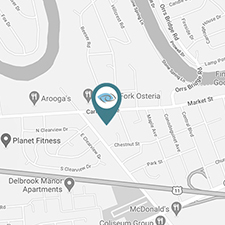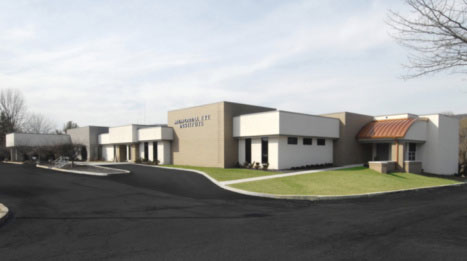Are you considering LASIK? Even though LASIK has been improving people’s eyesight for over 20 years, myths about LASIK still exist!
If you’ve decided to correct your vision with LASIK permanently, it’s essential to feel confident about your choice. Keep reading to learn how to set the record straight about LASIK myths and if it could be the right vision correction procedure for you!
Myth #1: I’m Too Old (or Young) to Be a Good Candidate for LASIK

Fact: Although you must be at least 18 to undergo LASIK, technically, there’s no upper age limit to be a good candidate for the procedure. Two of the most critical factors for candidacy are healthy eyes and having a stable prescription.
Healthy eyes mean you can’t have other eye conditions beyond refractive errors. Although you can have LASIK at an older age, you’re more likely to have age-related eye conditions like cataracts, glaucoma, and age-related macular degeneration.
You will not be a good LASIK candidate if you have these eye conditions. If you’re younger than 18, you also can’t get LASIK because your prescription is likely to still be changing.
Having an unstable prescription would render LASIK effectively useless. If you’re not yet 18 and want LASIK, the best thing you can do is wait to have the procedure.
Waiting will ensure that your eyes have finished developing, and you’ll get the best possible results when you have LASIK.
Myth #2: People with Astigmatism Can’t Get LASIK
Fact: Advances in LASIK technology mean that astigmatism won’t prevent you from being a good candidate for LASIK. Many people who opt for LASIK have refractive errors like astigmatism.
Astigmatism occurs when the cornea is misshapen. Rather than being round like a basketball, the cornea is closer in shape to a football. Because of this, vision is distorted.
During LASIK, femtosecond and excimer lasers reshape the cornea to correct vision. It can correct astigmatism by reducing the cornea’s curvature that causes astigmatism.
Ready for LASIK?
Find out if you’re a candidate.
Myth #3: LASIK Only Corrects Nearsightedness
Fact: LASIK can correct more than nearsightedness. LASIK can correct all refractive errors, including nearsightedness, farsightedness, and astigmatism.
However, your prescription must be within the treatment levels of what LASIK can treat. Choosing to correct your vision with LASIK not only allows you to see clearly at all distances but also allows you to see things more crisply.
Many LASIK patients report an improved ability to see contrast following the procedure.
Myth #4: The Effects of LASIK Do Not Last
Fact: After you’ve corrected your vision with LASIK, it is a permanent procedure. Because the effects of aging do not alter the cornea, the results of LASIK are long-lasting.
However, LASIK only reshapes the cornea, which corrects refractive errors. Because of this, getting LASIK will not affect whether or not you develop age-related eye conditions like presbyopia, cataracts, or age-related macular degeneration.
Myth #5: LASIK is Painful
Fact: The LASIK procedure is painless. Before LASIK begins, your Memorial Eye Institute LASIK surgeon will start by giving you numbing eye drops. These eye drops ensure you won’t feel any pain during the procedure.
Following LASIK, you will be sent home with medicated eye drops to soothe your eyes and speed up recovery. You may experience some mild discomfort immediately following LASIK, but this should go away within a day or two of having the procedure. As you continue healing, you’ll be left with crisper, clearer vision than you ever thought possible!
Myth #6: LASIK Has Long Recovery Times

Fact: LASIK has an incredibly short recovery time, meaning you can get back to the things you love with better vision in no time at all. While you should take it easy the day of your LASIK procedure, most LASIK patients find they are ready to resume their regular routines the day after the procedure.
Other vision-correcting options, like refractive lens exchange and PRK, have much longer recovery times. While these procedures may be the best option for people who are not good candidates for LASIK, it can take longer to recover and may mean more time before you see visual improvements.
Myth #7: LASIK Causes Dry Eye Syndrome
Fact: Although you may notice that your eyes feel drier during the recovery process from LASIK, it doesn’t mean you’ll develop dry eye syndrome. Dry eye syndrome is a serious eye condition that is caused by insufficient or faulty tear production.
Dry eyes after LASIK are a side effect that some patients may experience, which usually goes away after the eyes heal. If you experience temporary discomfort from dry eyes after LASIK, you can use eye drops and artificial tears to minimize these symptoms.
Learn More About LASIK!
Myth #8: LASIK Has a High Risk of Complications and Side Effects
Fact: Complications from LASIK are extremely rare, with clinical studies showing a mere 1% chance of complications from the procedure. You are far more likely to develop an eye infection from wearing contact lenses than complications from LASIK.
Some LASIK patients report short-term side effects like light sensitivity or glare after the procedure, but these issues typically subside within a few months. LASIK patients are carefully monitored following the procedure by attending follow-up appointments.
If there are signs of infection or complications, your ophthalmologist can intervene quickly.
Myth #9: LASIK isn’t Safe
Fact: Although all surgical procedures have some risk, LASIK is one of the safest vision-correcting procedures. Every year, LASIK is safely performed on approximately 800,000 people worldwide.
One of the reasons that LASIK is so safe is the advanced technology used to perform a LASIK procedure. LASIK surgeons use state-of-the-art lasers for more precise treatment and optimal vision outcomes.
Myth #10: LASIK is More Expensive than Glasses or Contact Lenses
Fact: Although LASIK seems expensive, it’s not when you compare it to the annual costs of glasses and contact lenses. Consider how much you pay for these visual aids annually.
Most patients pay an average of $500 per year. Getting LASIK is a one-time upfront cost that will allow you to cut these costs from your budget. Most patients also use financing to help pay for their LASIK procedure.
Patients typically pay off their LASIK procedure with financing in as little as two years. After that, you’ll own your clear vision.
Imagine what you could do if you had that extra $500 in your pocket every year. It could go a long way!
But getting LASIK is also a fantastic way of investing in yourself. Whether you want to increase your self-confidence, save time and money, or want better vision, LASIK is an excellent choice. Why let the myths stop you from changing your life for the better?
Today, take the next step by requesting your LASIK consultation at Memorial Eye Institute in Harrisburg and Camp Hill, PA! You’ve got everything to gain by choosing better vision!



